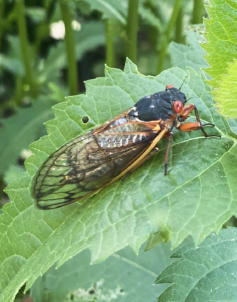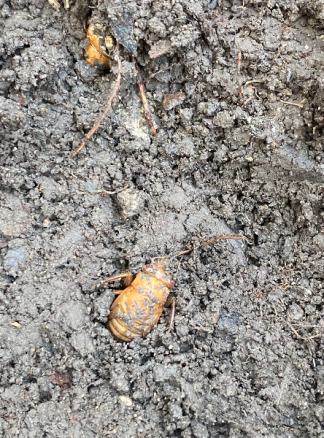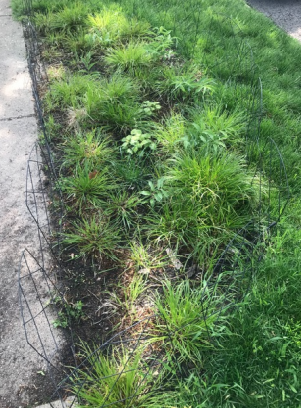Cicada Symphony: A Summer Serenade for Chicago Area Gardens (And What It Means for Your Trees)
Oh why, Brood X, has it been so long? since we last heard your cicada song?
since we last heard your cicada song?
Birds and dogs await your arrival.
Predator satiation, your best chance of survival.
You’ll emerge from your shells, bask in the light.
You may even mate. No need to swipe right.
You’re living proof of nature’s magic.
Even if you are somewhat lethargic.
— Mac Greer, Arlington, VA
Cicada in an Evanston garden, photo by Ashley Benirschke
Trying to remember the experience I had living in this region, 17 years ago, in relationship to the Cicadas, I have a confession to make. It was before I was truly aware of my inextricable relationship with the natural world. My awakening at the deepest level has been long and slow in emerging. It was a longing and desire for Life that sat underground, feeding and being nourished, sort of like the Cicadas. My enhanced curiosity and desire to understand the natural world has finally come to the surface. Instead of staying on the surface, as with so many of my more superficial thoughts and aesthetic desires, this deep desire to grow that connection for all of us to this magical world we live in, has launched on a clumsy but ardent flight that, though it may be short-lived, may hopefully ignite that same desire in others.
Julia Bunn, Spirited Gardener
Cicada Symphony: A Summer Serenade for Chicago Area Gardens (And What It Means for Your Trees)
Get ready, Chicagoland gardeners! This summer, a natural phenomenon is about to unfold in our midst. The 17-year cicadas, Brood XIII, are emerging from their subterranean slumber for a grand reunion above ground. While their chorus might be deafening at times, these fascinating insects are more of a curiosity than a cause for concern, especially for our gardens and trees.
The Cicada Life Cycle: A 17-Year Wait for a Few Weeks of Fame
These periodical cicadas have spent the last 17 years underground, feeding on tree roots and maturing. Now, they're ready to emerge en masse, shed their exoskeletons, sing their hearts out, mate, lay eggs, and then complete their life cycle.
How Cicadas Affect Gardens and Trees
Protecting Young Trees
While mature trees can generally withstand the cicadas' egg-laying habits, young trees (those with a trunk diameter of less than 2 inches) are more vulnerable. The slits that female cicadas make to deposit their eggs can weaken branches, leading to breakage or "flagging" (wilting and browning of the tips).
Here's how you can protect your young trees:
Embracing the Cicada Symphony
Instead of fearing them, try to appreciate this rare and fascinating natural event:
Remember, cicadas are not pests. They don't bite or sting, and they won't harm your vegetable garden. In fact, after they die off, their bodies decompose and add valuable nutrients to the soil.
So, turn down the music, sit back, and enjoy nature's concert this summer!!
_________________________________________________________________________________________________________________________________________
EcoFun Fact: Managing Rain Water - Vital to Climate Health Around World
I recently came across this video from LeadFoundation.Org and I found it incredibly inspiring. Utilizing rainwater in every region of the world is vital to climate health. And the crescents reminded me of my crescent sidewalk Rain Gardens that help to manage rainwater from uneven sidewalk areas. (Pictured below)
 Countries have found many different ways to manage/utilize rainwater:
Countries have found many different ways to manage/utilize rainwater:
Australia: Due to frequent droughts, Australia has been a pioneer in rainwater harvesting. Many homes and buildings are equipped with rainwater tanks to collect runoff from roofs. This water is used for irrigation, toilet flushing, and even drinking after appropriate treatment.
Germany: Green roofs, which are covered in vegetation, are popular in Germany. These roofs absorb rainwater, reduce stormwater runoff, and provide insulation.
China: In some rural areas of China, traditional rainwater harvesting systems involve collecting water from roofs into underground cisterns. This water is then used for irrigation and household needs.
India: Johads, which are earthen dams built across small streams, are a traditional method of rainwater harvesting in India. They create small reservoirs that recharge groundwater and provide water for irrigation.
Singapore: This densely populated city-state has developed an extensive network of drains and canals to manage rainwater and prevent flooding. They also have large-scale rainwater harvesting reservoirs that provide drinking water.
Here in the Midwest US, Spirited Gardener, has been an advocate for managing our rain water influxes with rain gardens.
All buildings have downspouts. Where ever possible on a property, with proper grading, that water can be captured and kept in our region.
By keeping that water in the local trans-evaporation cycle utilizing locally evolved, native plants we:
 since we last heard your cicada song?
since we last heard your cicada song?Birds and dogs await your arrival.
Predator satiation, your best chance of survival.
You’ll emerge from your shells, bask in the light.
You may even mate. No need to swipe right.
You’re living proof of nature’s magic.
Even if you are somewhat lethargic.
— Mac Greer, Arlington, VA
Cicada in an Evanston garden, photo by Ashley Benirschke
Trying to remember the experience I had living in this region, 17 years ago, in relationship to the Cicadas, I have a confession to make. It was before I was truly aware of my inextricable relationship with the natural world. My awakening at the deepest level has been long and slow in emerging. It was a longing and desire for Life that sat underground, feeding and being nourished, sort of like the Cicadas. My enhanced curiosity and desire to understand the natural world has finally come to the surface. Instead of staying on the surface, as with so many of my more superficial thoughts and aesthetic desires, this deep desire to grow that connection for all of us to this magical world we live in, has launched on a clumsy but ardent flight that, though it may be short-lived, may hopefully ignite that same desire in others.
Julia Bunn, Spirited Gardener
Cicada Symphony: A Summer Serenade for Chicago Area Gardens (And What It Means for Your Trees)
Get ready, Chicagoland gardeners! This summer, a natural phenomenon is about to unfold in our midst. The 17-year cicadas, Brood XIII, are emerging from their subterranean slumber for a grand reunion above ground. While their chorus might be deafening at times, these fascinating insects are more of a curiosity than a cause for concern, especially for our gardens and trees.

The Cicada Life Cycle: A 17-Year Wait for a Few Weeks of Fame
These periodical cicadas have spent the last 17 years underground, feeding on tree roots and maturing. Now, they're ready to emerge en masse, shed their exoskeletons, sing their hearts out, mate, lay eggs, and then complete their life cycle.
How Cicadas Affect Gardens and Trees
- Song and Dance: The male cicadas' loud calls, meant to attract mates, will have the most noticeable impact on your garden. While it might be surprising, it's not harmful to plants.
- Egg-laying: Female cicadas lay eggs in small slits they cut into young tree branches. This can cause some twig dieback, known as "flagging." While unsightly, this is generally not harmful to established trees. Young or newly planted trees, however, might need some protection (more on that below).
- Natural Aeration: When cicadas emerge from the ground, they create thousands of tiny holes that help aerate the soil – a bonus for your garden!
Protecting Young Trees
While mature trees can generally withstand the cicadas' egg-laying habits, young trees (those with a trunk diameter of less than 2 inches) are more vulnerable. The slits that female cicadas make to deposit their eggs can weaken branches, leading to breakage or "flagging" (wilting and browning of the tips).
Here's how you can protect your young trees:
- Timing is Key: Start protecting your trees in late spring, just before the cicadas emerge. You'll need to keep the protection in place for about 4-6 weeks, or until the cicadas have finished their life cycle.
- Netting: The most effective way to protect young trees is to wrap them in fine mesh netting, like tulle or cheesecloth. The holes in the netting should be smaller than a dime to prevent cicadas from getting through.
- W
rapping Technique:
- Start at the bottom of the tree and wrap the netting upwards, overlapping each layer by a few inches.
- Make sure the netting is loose enough to allow for air circulation and growth, but tight enough to prevent cicadas from crawling underneath.
- Secure the netting at the top with twine or twist ties, being careful not to damage the branches
- Don't Use Insecticides: Insecticides are not recommended for controlling cicadas, as they can harm beneficial insects and won't be effective against the massive numbers of cicadas emerging.
- Monitor and Maintain: Check your netting regularly to ensure it hasn't come loose or been damaged. Remove any cicadas that you find trapped in the netting
Embracing the Cicada Symphony
Instead of fearing them, try to appreciate this rare and fascinating natural event:
- Observe and Learn: Cicadas are incredible creatures! Observe their life cycle, listen to their unique calls, and marvel at their sheer numbers.
- Educate and Share: Help children and others learn about these amazing insects. Learn more about them here.
- Citizen Science: Consider participating in cicada research projects to help scientists track and study these fascinating creatures. You can easily help by submitting photos of periodical cicadas to iNaturalist or CicadaSafari. Or be directly involved in this study shared by Libby Hill from the Evanston North Shore Bird Club: From prior research on Brood X in 2021, we recorded over 80 bird species consuming cicadas in the state of Maryland alone. Knowing which birds forage for cicadas will help us understand indirect effects on arthropod and plant communities during their emergence. Join in this scientific discovery by watching birds and sharing your observations with us! A simple protocol with data entry forms is available here: https://friendtocicadas.org/brood-x-bird-feastprotocol/ And here are maps of Brood XIII and XIX . If you are interested in assisting with the cicada mapping project, join the Cicada Safari! Contact: CicadaBirdFeast@gmail.com
- Culinary Curiosity? While not common in the US, cicadas are considered a delicacy in some cultures. If you're feeling adventurous, you can find plenty of information online!
Remember, cicadas are not pests. They don't bite or sting, and they won't harm your vegetable garden. In fact, after they die off, their bodies decompose and add valuable nutrients to the soil.
So, turn down the music, sit back, and enjoy nature's concert this summer!!
_________________________________________________________________________________________________________________________________________
EcoFun Fact: Managing Rain Water - Vital to Climate Health Around World
I recently came across this video from LeadFoundation.Org and I found it incredibly inspiring. Utilizing rainwater in every region of the world is vital to climate health. And the crescents reminded me of my crescent sidewalk Rain Gardens that help to manage rainwater from uneven sidewalk areas. (Pictured below)
 Countries have found many different ways to manage/utilize rainwater:
Countries have found many different ways to manage/utilize rainwater: Australia: Due to frequent droughts, Australia has been a pioneer in rainwater harvesting. Many homes and buildings are equipped with rainwater tanks to collect runoff from roofs. This water is used for irrigation, toilet flushing, and even drinking after appropriate treatment.
Germany: Green roofs, which are covered in vegetation, are popular in Germany. These roofs absorb rainwater, reduce stormwater runoff, and provide insulation.
China: In some rural areas of China, traditional rainwater harvesting systems involve collecting water from roofs into underground cisterns. This water is then used for irrigation and household needs.
India: Johads, which are earthen dams built across small streams, are a traditional method of rainwater harvesting in India. They create small reservoirs that recharge groundwater and provide water for irrigation.
Singapore: This densely populated city-state has developed an extensive network of drains and canals to manage rainwater and prevent flooding. They also have large-scale rainwater harvesting reservoirs that provide drinking water.
Here in the Midwest US, Spirited Gardener, has been an advocate for managing our rain water influxes with rain gardens.
All buildings have downspouts. Where ever possible on a property, with proper grading, that water can be captured and kept in our region.
By keeping that water in the local trans-evaporation cycle utilizing locally evolved, native plants we:
- Build local groundwater for our trees in times of drought
- Send that moisture back into the air through the living plants, our allies in keeping our region vital and alive
- Support that aliveness by the habitats these plants create for the birds, bees and local creatures
- Participate in this circle of life, we feel a calmness and joyful connection




